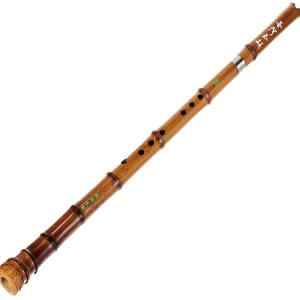Shakuhachi
 The shakuhachi was widely played throughout medieval Japan, but its fame was particularly associated with Zen Buddhism, a religion that (like the flute) was based in Chinese origins and uniquely interpreted for Japanese people over centuries. In particular, the shakuhachi was a favored instrument of the Fuke sect of Buddhism. In the 13th century, the Fuke monks decided to replace their tradition chanting with the shakuhachi, developing a tradition of sui zen, or blowing zen.
The shakuhachi was widely played throughout medieval Japan, but its fame was particularly associated with Zen Buddhism, a religion that (like the flute) was based in Chinese origins and uniquely interpreted for Japanese people over centuries. In particular, the shakuhachi was a favored instrument of the Fuke sect of Buddhism. In the 13th century, the Fuke monks decided to replace their tradition chanting with the shakuhachi, developing a tradition of sui zen, or blowing zen.
Throughout Japanese history, many cultural traditions entered the islands from China and Korea, then were interpreted through uniquely Japanese innovations. The shakuhachi is no exception. During China's Tang Dynasty, which had a strong policy of cultural expansion, the first flute of this style arrived in Japan, likely via Korea in the 6th century. It was called the gagaku sakuhachi and was part of an array of Chinese musical instruments to be sent from the imperial court of China to that of Japan. The gagaku shakahuchi became popular amongst the Japanese nobility for some time. However, the same flute fell out of style in China. By the 10th century, shakuhachi flutes could only be found in Japan.